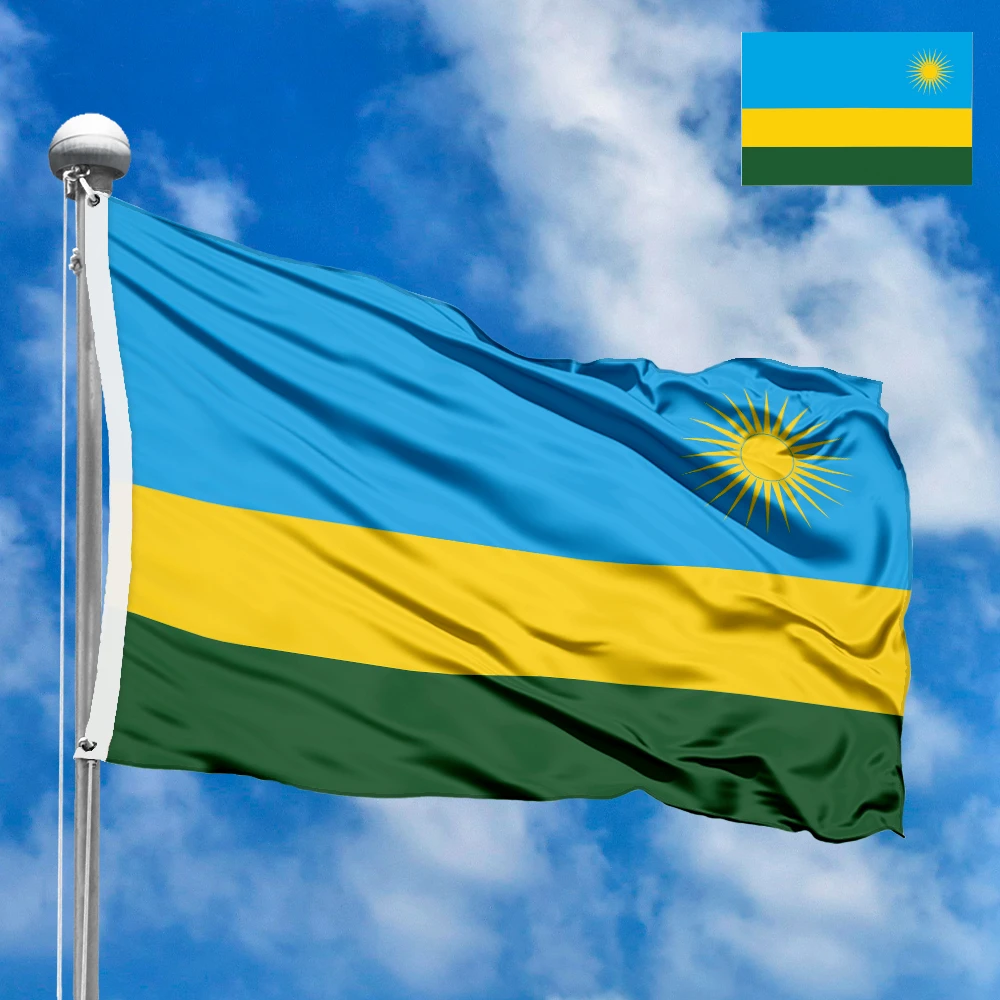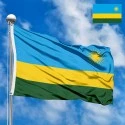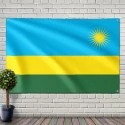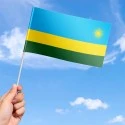The national flag of the Republic of Rwanda is a modern and symbolically rich emblem that reflects the nation's profound journey from a tumultuous past marked by genocide to a future envisioned with unity, peace, prosperity, and hope. Adopted on December 31, 2001, it replaced an older flag that had become associated with the tragic events of the 1994 genocide. The current flag's design represents a deliberate and powerful break from the past, embodying the country's commitment to reconciliation, reconstruction, and a brighter tomorrow.
Design and Symbolism: A Dawn of Hope and Prosperity
The flag of Rwanda features four horizontal stripes of varying widths: a wide light blue stripe at the top, a thinner yellow stripe below it, and an even thinner green stripe at the bottom. In the upper fly (right) corner of the light blue stripe, there is a golden-yellow sun with 24 rays. Each color and element holds deep symbolic meaning:
-
Light Blue Stripe (Top): The broad light blue stripe at the top of the flag represents peace and tranquility. After years of devastating conflict, this color signifies Rwanda's unwavering commitment to fostering a peaceful society, both internally and with its neighbors. It embodies the calm and stability that the nation strives for in its post-genocide era.
-
Yellow Stripe (Middle): The yellow stripe, narrower than the blue but wider than the green, symbolizes economic development and prosperity. It reflects the hard work and dedication of the Rwandan people in rebuilding their nation and their aspirations for a flourishing economy. It represents the hope for a better future, driven by progress and growth.
-
Green Stripe (Bottom): The narrowest green stripe at the bottom of the flag signifies hope of prosperity and the natural resources of the country. It represents Rwanda's rich agricultural lands, its lush landscapes, and its commitment to environmental sustainability. Green also symbolizes the optimism for a brighter future and the fertile ground for progress.
-
Golden-Yellow Sun with 24 Rays (Upper Fly Corner): The golden-yellow sun, positioned in the upper fly corner of the light blue stripe, is the most distinctive and poignant element of the flag. This sun symbolizes enlightenment, unity, transparency, and the dawning of a new era.
-
The golden-yellow color reflects the radiance and warmth of the sun, bringing light and hope after darkness.
-
The 24 rays emanating from the sun are not explicitly defined in official interpretations, but they often represent the continuous progress and the shining light that guides Rwanda forward. The sun's position in the upper corner, over the blue (peace) stripe, suggests that this new era of enlightenment and unity shines over a peaceful nation.
The combination of these elements clearly communicates Rwanda's forward-looking vision, emphasizing reconciliation over past divisions and focusing on collective prosperity and peace.
Dimensions and Proportions:
The official proportions of the Flag of Rwanda are a width-to-length ratio of 2:3. The three horizontal bands are not of equal width. The light blue band at the top is the broadest, followed by the yellow band, and the green band is the narrowest at the bottom. The golden-yellow sun with its 24 rays is strategically placed in the upper fly quarter of the light blue stripe, ensuring its prominence and visibility. The careful scaling of the sun ensures it integrates harmoniously with the overall flag design without overpowering the stripes.
History and Evolution: A Symbolic Break from the Past
The history of the Rwandan flag is deeply intertwined with the nation's turbulent political landscape and, most significantly, the aftermath of the 1994 genocide against the Tutsi.
-
First National Flag (1962-2001): Upon gaining independence from Belgium on July 1, 1962, Rwanda adopted its first national flag. This flag consisted of three vertical stripes of red, yellow, and green, with a large black "R" (for Rwanda) in the center of the yellow stripe.
-
Red: Symbolized the bloodshed during the struggle for freedom.
-
Yellow: Represented peace and hope.
-
Green: Stood for hope and prosperity.
-
The Black "R": Was added to distinguish it from the similar flag of Guinea (which also used red, yellow, and green vertical stripes). However, over time, this flag became inextricably linked to the Hutu-led government that orchestrated the 1994 genocide. For many, it represented the division and hatred that led to the atrocities.
-
Post-Genocide Need for Change: Following the end of the genocide, there was a widespread consensus that the symbols of the past needed to be replaced to foster national unity and reconciliation. The old flag evoked painful memories and served as a divisive symbol rather than a unifying one. A new flag, along with a new national anthem and coat of arms, was seen as essential for nation-building and moving forward.
-
Adoption of the Current Flag (2001): The current flag was officially adopted on December 31, 2001. Its design was chosen through a national competition, emphasizing themes of peace, unity, and development. The new flag intentionally moved away from the Pan-African colors (red, yellow, green) in their traditional configuration to signal a complete break from the past, though the new design still incorporates green and yellow, alongside blue. The sun, a universal symbol of new beginnings and hope, became the central motif for the new era in Rwanda.
Regional Context and East African Identity:
Rwanda is a landlocked country in East Africa, often referred to as the "Land of a Thousand Hills." While many African flags adopted Pan-African colors to express solidarity and a shared history of struggle against colonialism, Rwanda's current flag took a different approach, particularly in its color arrangement and the prominent sun symbol.
This deliberate departure from the traditional Pan-African vertical stripes (as seen in flags like those of Mali, Guinea, or Senegal) highlights Rwanda's unique post-genocide context. While it retains some Pan-African colors (green and yellow), their arrangement and the introduction of light blue and the prominent sun signify a focus on internal peace, reconstruction, and a forward-looking vision rather than solely on continental solidarity or past revolutionary struggles. This makes Rwanda's flag distinctive within the East African community and on the broader African continent, underscoring its specific national narrative of healing and progress.
Interesting Facts:
-
Replacement Flag: The current flag replaced an older design that was associated with the 1994 genocide, making it a powerful symbol of national renewal.
-
Designed for Unity: Its primary purpose was to promote national unity and reconciliation after the devastating genocide.
-
Colors with Specific Meanings: Each color (light blue, yellow, green) and the sun have clear, forward-looking symbolic meanings: peace, prosperity, hope, and enlightenment.
-
No Red: Unlike many African flags that use red to symbolize bloodshed during liberation struggles, Rwanda's new flag deliberately omits red, signifying a desire to move beyond a history of violence.
-
Sun of Enlightenment: The golden-yellow sun is a unique and dominant feature, representing a new dawn for the nation.
-
Part of a Larger Symbolic Change: The flag's adoption was part of a broader national effort that included a new national anthem and a new coat of arms, all aimed at fostering a fresh national identity.
-
Symbol of Resilience: For many, the flag is a powerful testament to the resilience of the Rwandan people and their commitment to building a harmonious future.
-
Modern Design: Its horizontal layout and the placement of the sun give it a contemporary feel compared to many traditional African flags.
Significance for the Inhabitants: A Banner of Hope, Reconciliation, and Progress
For the people of Rwanda, their national flag is an incredibly significant and cherished symbol. It stands as a powerful reminder of the nation's rebirth and its profound commitment to overcoming the horrors of the past. Unlike the previous flag, which evoked painful and divisive memories, the current flag represents a collective aspiration for a united, peaceful, and prosperous future.
The light blue stripe immediately conveys a sense of calm and the yearning for peace, a deeply felt desire after years of conflict. The yellow and green stripes instill hope for economic development and sustainable growth, reflecting the tireless efforts of Rwandans to rebuild their country. The golden-yellow sun, shining brightly in the corner, is perhaps the most emotionally resonant element. It symbolizes a new dawn, a fresh start, and the collective enlightenment that has allowed the nation to confront its history, foster reconciliation, and forge a path forward.
When the flag is proudly displayed during national holidays, commemorative events, or community gatherings, it evokes a strong sense of national pride, resilience, and a shared commitment to the "One Rwanda" vision. It serves as a visual pledge that the atrocities of the past will never be repeated, and that the future will be built on principles of unity, hard work, and mutual respect. The flag is a constant source of inspiration, embodying the spirit of a people determined to rise from the ashes and build a vibrant, harmonious, and prosperous nation for generations to come.
In the demonstration images, full-size flags are shown with proportions of 2:3, and hand-held flags with proportions of 1:2.







 Waving flag
Waving flag
 Sizes:
Sizes:
 Round flag
Round flag
 Sizes:
Sizes:
 Rectangular flag 2:3
Rectangular flag 2:3
 Sizes:
Sizes: